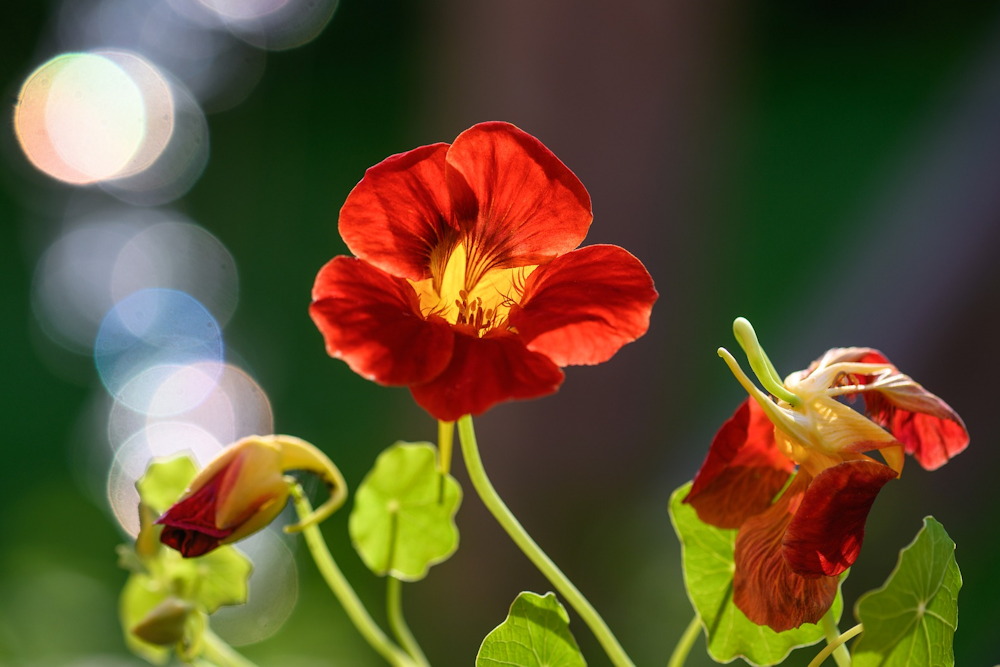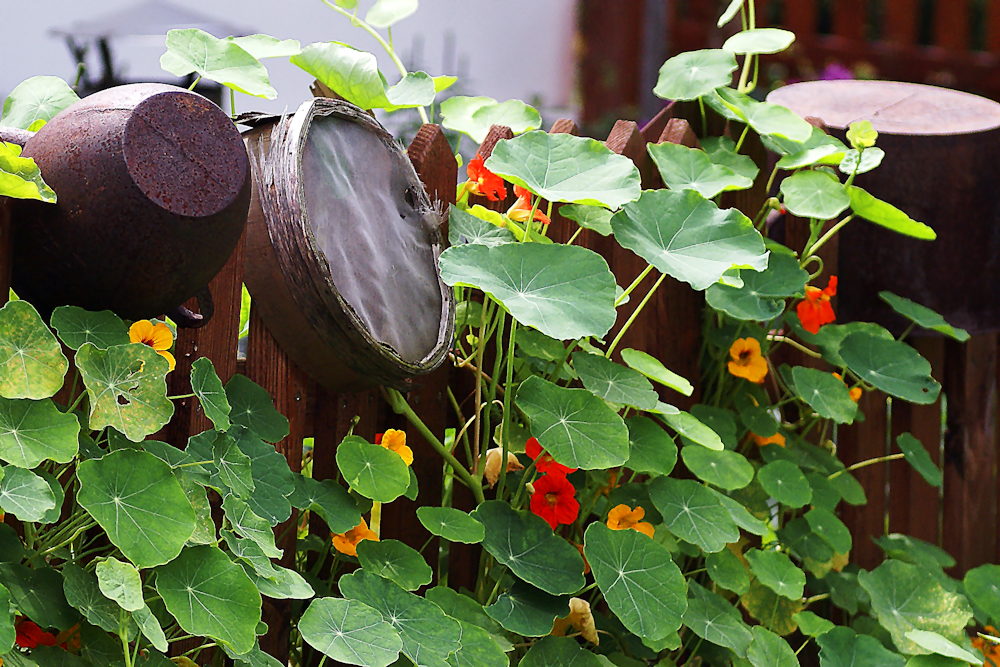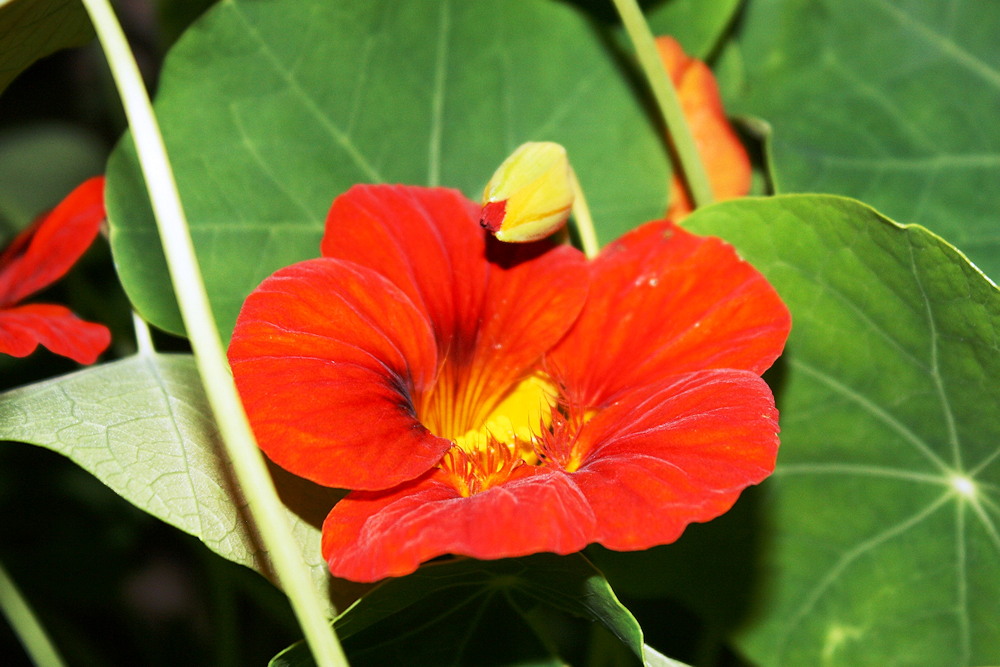Nasturtium is not just a visually appealing flower; it’s a multifaceted plant renowned for its vibrant blooms, ease of cultivation and culinary applications. Originating from South America, this remarkable plant has found its way into gardens and kitchens around the world.
Origin and Description: A Burst of Color and Beauty
Nasturtium, scientifically known as Tropaeolum majus, hails from the Andes region of South America. Revered for its dazzling colors and distinctively shaped leaves, this plant offers a feast for the eyes. With flowers ranging from warm yellows and oranges to deep reds, it is a favorite among gardeners for adding a pop of color to landscapes.

Cultivation Tips: Growing Joy and Abundance
Cultivating nasturtiums is a delight even for novice gardeners. These hardy plants thrive in well-drained soil and enjoy full to partial sunlight. They’re perfect for both garden beds and containers. Plant the seeds directly in the soil after the last frost, and watch as their vibrant foliage and blossoms bring life to your space. Regular deadheading will encourage continuous blooming throughout the growing season.

Beyond Ornamental Beauty: Nasturtium as an Edible Plant and Its Culinary Uses
Beyond its visual appeal, nasturtium offers a delightful culinary dimension. Both the leaves and flowers are edible, boasting a peppery, slightly tangy flavor reminiscent of arugula. Their unique taste adds a lively kick to salads, sandwiches and other dishes. Rich in vitamin C and antioxidants, nasturtiums not only enhance the flavor profile of a meal but also provide a healthful boost.

Nasturtium Salad with Honey-Lemon Dressing
Create a stunning and flavorful nasturtium salad by combining fresh nasturtium leaves and flowers with mixed greens. Top with goat cheese, toasted walnuts and a drizzle of honey-lemon dressing. The combination of peppery, sweet and tangy flavors makes this salad a true culinary delight.

A Taste of Floral Delight: Nasturtium Butter Recipe
Ingredients
- 1/2 cup unsalted butter, softened
- Handful of fresh nasturtium flowers and leaves
- Zest of 1 lemon
- Salt to taste
Instructions
- Wash and dry the nasturtium flowers and leaves carefully to remove any dirt or insects.
- In a mixing bowl, combine the softened butter with the lemon zest and a pinch of salt. Mix well until the zest is evenly distributed.
- Gently chop the nasturtium leaves and flowers into small pieces, releasing their vibrant flavors.
- Fold the chopped nasturtium pieces into the butter mixture, ensuring they are well incorporated.
- Place the flavored butter mixture onto a piece of plastic wrap or parchment paper.
- Roll the butter mixture into a log shape, using the wrap or paper to help shape it.
- Twist the ends of the wrap or paper to secure the butter log, then refrigerate for at least an hour to allow the flavors to meld.
- Once chilled and firm, slice the nasturtium-infused butter into rounds and use it to elevate the taste of your dishes.
Usage Ideas
Spread the nasturtium butter over freshly baked bread, melt it onto steamed vegetables or use it to add a unique flavor to grilled meats. The floral and peppery notes of nasturtium will infuse a delightful twist into your culinary creations.
Note: Ensure that the nasturtium flowers and leaves you use for the butter are pesticide-free and safe for consumption.
This recipe showcases how nasturtium can be incorporated into unexpected yet delicious culinary creations, enhancing both the taste and visual appeal of your dishes.

A Closer Look: 5 Tidbits About Nasturtium
- Natural Pest Repellent: Nasturtiums act as a natural pest repellent in gardens, effectively deterring aphids and other insects from attacking nearby plants.
- Historical Significance: The name “nasturtium” is derived from the Latin words “nasus tortus,” meaning “twisted nose,” referring to its pungent aroma.
- Medicinal Traditions: In traditional herbal medicine, nasturtiums have been used to address respiratory issues and promote overall wellness.
- Cultural Symbolism: These vibrant flowers are often associated with conquest and victory due to their use in ancient Roman and Incan ceremonies.
- Culinary Creativity: Nasturtiums can be pickled, lending a unique flavor to dishes. The pickled seeds are sometimes used as a caper substitute. When using nasturtium seeds for pickling, it’s the younger, green seeds that are usually preferred to achieve the desired flavor profile.

A Blossoming Gem in Gardens and Kitchens
Nasturtium transcends its role as a mere ornamental plant, offering both aesthetic beauty and culinary charm. With its easy cultivation, colorful blooms and peppery flavor, it has carved a niche in gardens and kitchens worldwide. From salads to pickles, nasturtiums continue to captivate our senses and enrich our culinary experiences.












